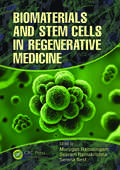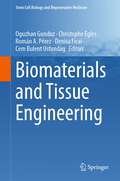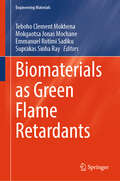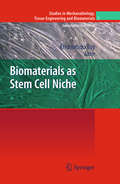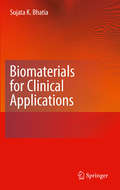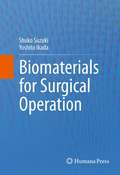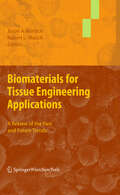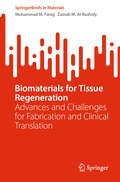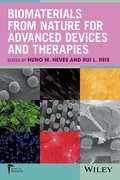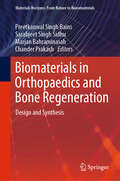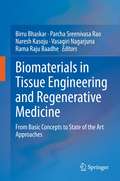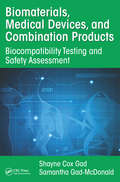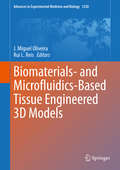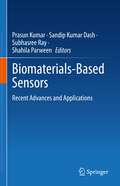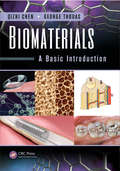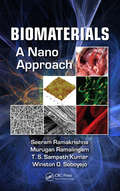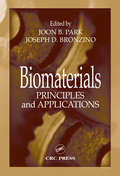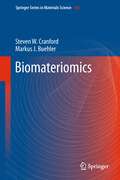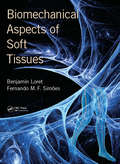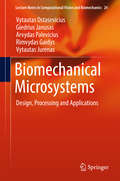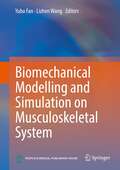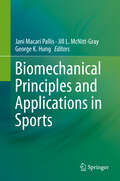- Table View
- List View
Biomaterials and Stem Cells in Regenerative Medicine
by Seeram Ramakrishna Murugan Ramalingam Serena BestWork in the area of biomaterials and stem cell therapy has revealed great potential for many applications, from the treatment of localized defects and diseases to the repair and replacement of whole organs. Researchers have also begun to develop a better understanding of the cellular environment needed for optimal tissue repair and regeneration. Bi
Biomaterials and Tissue Engineering (Stem Cell Biology and Regenerative Medicine #74)
by Oguzhan Gunduz Christophe Egles Román A. Pérez Denisa Ficai Cem Bulent UstundagThis contributed volume covers all fundamental principles for researchers and professionals interested in the field of Biomaterials and Tissue Engineering, an interdisciplinary field of research with contributions from biomedical scientists, engineers, and physicians. With a strong focus on biomaterials and scaffolds, the book also covers testing and evaluation pathways for in vitro and in vivo studies. This book also presents a broad range of topics including fundamentals of 3D printing and bioprinting, followed by contemporary technology used in tissue engineering applications as well as currently available biomaterials suitable for tissue repair and regeneration. This volume provides information on: (i) why humans need biomaterials, especially in medical applications, (ii) different types of tissue engineering strategies, and (iii) modeling, characterization, and evaluation of outputs of those strategies. This book is a reference material in the field of tissue engineering, and it is very useful for bachelor, M.Sc., and Ph.D. students, researchers, academics, medical, industry, and healthcare professionals from diverse backgrounds.
Biomaterials as Green Flame Retardants (Engineering Materials)
by Suprakas Sinha Ray Teboho Clement Mokhena Mokgaotsa Jonas Mochane Emmanuel Rotimi SadikuThis book highlights the utilization of biomaterials as emerging suitable and effective flame retardants (FRs) to replace most of the conventional FRs (e.g., halogenated FRs). Biomaterials are considered to be sustainable, biodegradable, and renewable resources. They are abundantly available, which makes them affordable. Information and findings on the characteristics of biomaterials and their use as FRs have been explored. Herein, the tremendous scientific progress made in using biomaterials as flame retardants for a wide range of products is elucidated. The major goal is to draw attention to the opportunities and challenges of switching to biomaterial-based FRs in place of conventional FRs in order to create a sustainable society.
Biomaterials as Stem Cell Niche (Studies in Mechanobiology, Tissue Engineering and Biomaterials #2)
by Krishnendu RoyRecent developments in stem cell biology have opened new directions in cell therapy. This book provides the state-of-the-art developments in using biomaterials as artificial niches for engineering stem cells, both for the purpose of better understanding their biology under 3D biomimetic conditions as well as for developing new strategies for efficient long term maintenance and directed differentiation of stem cells into various therapeutic lineages. Animal and human stem cells of both embryonic and adult origin are discussed with applications ranging from nerve regeneration, orthopedics, cardiovascular therapy, blood cell generation and cancer therapy. Both synthetic and natural biomaterials are reviewed with emphasis on how material-stem cell interactions direct specific signaling pathways and ultimately modulate the cell fate. This book is valuable for biomaterial scientists, tissue engineers, clinicians as well as stem cell biologists involved in basic research and applications of adult and embryonic stem cells.
Biomaterials for Cell Delivery: Vehicles in Regenerative Medicine (Gene and Cell Therapy)
by Aaron S. GoldsteinThe purpose of this book is to summarize key strategies and recent accomplishments in the area of developing cell/biomaterial constructs for regenerative medicine. The first section is a review of the state-of-the-art of biomaterial carriers and is divided into synthetic and natural materials. A subset of the latter are decellularized organs which retain the structure and some of the biological activities of the target organ. The bulk of the book is devoted to unique problems associated with key tissue and organ targets. Key selling features: Describes developing cell/biomaterial constructs for regenerative medicine Reviews state-of-the-art of biomaterial carriers Summarizes the unique problems associated with key tissue and organ targets Discusses issues associated with clinical translation including quality control, manufacturing practices, nondestructive imaging, and animal models
Biomaterials for Clinical Applications: Novel Technologies For Clinical Applications
by Sujata K. BhatiaBiomaterials for Clinical Applications is organized according to the World Health Organization's report of the top 11 causes of death worldwide, and lays out opportunities for both biomaterials scientists and physicians to tackle each of these leading contributors to mortality. The introductory chapter discusses the global burden of disease. Each of the subsequent eleven chapters focuses on a specific disease process, beginning with the leading cause of death worldwide, cardiovascular disease. The chapters start with describing diseases where clinical needs are most pressing, and then envisions how biomaterials can be designed to address these needs, instead of the more technologically centered approached favored by most books in the field. This book, then, should appeal to chemical engineers and bioengineers who are designing new biomaterials for drug delivery and vaccine delivery, as well as tissue engineering.
Biomaterials for Surgical Operation
by Yoshito Ikada Shuko SuzukiBiomaterials for Surgical Operation offers a review of the latest advances made in developing bioabsorbable devices for surgical operations which include surgical adhesives (sealants), barriers for the prevention of tissue adhesion, polymers for fractured bone fixation, growth factors for the promotion of wound healing, and sutures. Over the years, many descriptions of biomaterials have appeared in academic journals and books, but most of them have been devoted to limited clinical areas. This is in marked contrast with this volume which covers a wide range of bioabsorbable devices used in surgery from a practical point of view. The currently applied polymeric devices are critical in surgery, but all involve serious problems due to their poor performance. For instance, fibrin glue, the most widely used surgical sealant, can produce only a weak gel with low adhesive strength to tissues, accentuating the limited effectiveness of current treatment options. Likewise, the currently available barrier membranes cannot fully prevent tissue adhesion at the acceptable level and are, moreover, not easy to handle with endoscopes due to their poor mechanical properties. Biomaterials for Surgical Operation is aimed at those who are interested in expanding their knowledge of how the problems associated with the currently used devices for surgical operation can be solved. It primarily focuses on the absorbable biomaterials which are the main components of these medical devices.
Biomaterials for Tissue Engineering Applications: A Review of the Past and Future Trends
by Robert L. Mauck Jason A. BurdickA concise overview of tissue engineering technologies and materials towards specific applications, both past and potential growth areas in this unique discipline is provided to the reader. The specific area of the biomaterial component used within the paradigm of tissue engineering is examined in detail. This is the first work to specifically covers topics of interest with regards to the biomaterial component. The book is divided into 2 sections: (i) general materials technology (e.g., fibrous tissue scaffolds) and (ii) applications in the engineering of specific tissues (e.g., materials for cartilage tissue engineering). Each chapter covers the fundamentals and reflects not only a review of the literature, but also addresses the future of the topic. The book is intended for an audience of researchers in both industry and academia that are interested in a concise overview regarding the biomaterials component of tissue engineering, a topic that is timely and only growing as a field.
Biomaterials for Tissue Regeneration: Advances and Challenges for Fabrication and Clinical Translation (SpringerBriefs in Materials)
by Mohammad M. Farag Zainab M. Al-RashidyThis book comprehensively reviews the essential characteristics of biomaterials and their designs important for applications in tissue regeneration. It delves into both past research milestones in tissue engineering and emerging trends poised for future integration. The primary focus lies on the evolution of biomaterial generations and the burgeoning domain of tissue engineering discovery. Furthermore, it examines various biomaterial categories, including bioceramics, bioactive glasses, synthetic and natural polymers, alongside their composite derivatives, all pivotal in scaffold fabrication, a cornerstone of tissue engineering. The book also looks at diverse scaffold fabrication methodologies, providing readers with a thorough understanding of the technical intricacies involved. The book showcases recent breakthroughs in tissue engineering across multiple fronts such as bone, skin, cartilage, neural, and cardiac regeneration, highlighting their potential as pre-clinical interventions for rehabilitating injured or diseased tissues and organs. Finally, it reviews the contemporary landscape of biomaterials for tissue regeneration, shedding light on emerging trends and confronting the challenges that lie ahead.
Biomaterials from Nature for Advanced Devices and Therapies
by Nuno M. Neves Rui L. ReisIn-depth information on natural biomaterials and their applications for translational medicine! Undiluted expertise: edited by world-leading experts with contributions from top-notch international scientists, collating experience and cutting-edge knowledge on natural biomaterials from all over the world A must-have on the shelf in every biomaterials lab: graduate and PhD students beginning their career in biomaterials science and experienced researchers and practitioners alike will turn to this comprehensive reference in their daily work Link to clinical practice: chapters on translational research make readers aware of what needs to be considered when a biomaterial leaves the lab to be routinely used
Biomaterials in Orthopaedics & Trauma: Current Status and Future Trends in Revolutionizing Patient Care
by Sourabh Ghosh Raju VaishyaThe landscape of orthopaedics and trauma is rapidly evolving, driven by groundbreaking advancements in biomaterials. This book offers an in-depth exploration of the current state-of-the-art, highlighting the latest innovations and their clinical applications. The intersection of materials science and medicine has given rise to a revolutionary field: biomaterials. These engineered substances, designed to interact with biological systems, have become indispensable in orthopaedics and trauma surgery. From repairing broken bones to replacing worn-out joints, biomaterials have significantly advanced patient care and quality of life. In recent years, the focus has shifted towards bioactive and biodegradable materials. Bioactive materials, such as calcium phosphate ceramics, actively interact with bone tissue, promoting bone growth and integration. This characteristic is particularly valuable in bone grafts and tissue engineering applications. On the other hand, biodegradable materials, like polylactic acid (PLA) and polyglycolic acid (PGA), offer the advantage of being gradually absorbed by the body as the surrounding tissue regenerates. These materials are employed in various forms, including screws, plates, and bone scaffolds. This book offers a holistic view of biomaterials in orthopaedics and trauma by presenting an understanding of the fundamental properties of biomaterials and exploring their role in tissue regeneration and implant design. This comprehensive resource also delves into the future, examining emerging trends and technologies that are revolutionizing patient care and paving the way for new treatment modalities. This book is an essential guide to the exciting world of biomaterials for orthopaedic surgeons, trauma surgeons and biomedical researchers.
Biomaterials in Orthopaedics and Bone Regeneration: Design and Synthesis (Materials Horizons: From Nature to Nanomaterials)
by Sarabjeet Singh Sidhu Preetkanwal Singh Bains Chander Prakash Marjan BahraminasabThis book focuses on the recent advances in the field of orthopaedic biomaterials, with a particular emphasis on their design and fabrication. Biomimetic materials, having similar properties and functions to that of the natural tissue, are becoming a popular choice for making customized orthopaedic implants and bone scaffolds. The acceptability of these materials in the human body depends on the right balance between their mechanical and biological properties. This book provides a comprehensive overview of the state-of-the-art research in this rapidly evolving field. The chapters cover different aspects of multi-functional biomaterials design, and cutting-edge methods for the synthesis and processing of these materials. Advanced manufacturing techniques, like additive manufacturing, used for developing new biomimetic materials are highlighted in the book. This book is a valuable reference for students and researchers interested in biomaterials for orthopaedic applications.
Biomaterials in Tissue Engineering and Regenerative Medicine: From Basic Concepts to State of the Art Approaches
by Birru Bhaskar Parcha Sreenivasa Rao Naresh Kasoju Vasagiri Nagarjuna Rama Raju BaadheThis book comprehensively explores the basic concepts and applications of biomaterials in tissue engineering and regenerative medicine. The book is divided into four sections; the first section deals with the basic concepts and different types of biomaterials used in tissue engineering. The second section discusses the functional requirements and types of materials that are used in developing state-of-the-art of scaffolds for tissue engineering applications. The third section presents the applications of biomaterials for hard and soft tissue engineering, as well as for specialized tissue engineering. The last section addresses the future prospects of nanobiomaterials, intelligent biomaterials, and 3D bioprinting biomaterials in tissue engineering and regenerative medicine. It also discusses various in vitro disease models for tissue bioengineering and regenerative medicine. As such, it offers a valuable resource for students, researchers, scientists, entrepreneurs, and medical/healthcare professionals.
Biomaterials, Medical Devices, and Combination Products: Biocompatibility Testing and Safety Assessment
by Shayne Cox Gad Samantha Gad-McDonaldBiomaterials, Medical Devices, and Combination Products is a single-volume guide for those responsible for-or concerned with-developing and ensuring patient safety in the use and manufacture of medical devices.The book provides a clear presentation of the global regulatory requirements and challenges in evaluating the biocompatibility and clinical
Biomaterials- and Microfluidics-Based Tissue Engineered 3D Models (Advances in Experimental Medicine and Biology #1230)
by Rui L. Reis J. Miguel OliveiraThis contributed volume reviews the latest advances on relevant 3D tissue engineered in vitro models of disease making use of biomaterials and microfluidics. The main focus of this book is on advanced biomaterials and microfluidics technologies that have been used in in vitro mimetic 3D models of human diseases and show great promise in revolutionizing personalized medicine. Readers will discover important topics involving biomaterials and microfluidics design, advanced processing techniques, and development and validation of organ- and body-on-a-chip models for bone, liver, and cancer research. An in depth discussion of microfabrication methods for microfluidics development is also provided. This work is edited by two truly multidisciplinary scientists and includes important contributions from well-known experts in their fields. The work is written for both early stage and experienced researchers, and well-established scientists enrolled in the fields of biomaterials, microfluidics, and tissue engineering, and is especially suited to those who wish to become acquainted with the principles and latest developments of in vitro models of diseases, such as professionals working in pharma, medicine, and engineering.
Biomaterials-Based Sensors: Recent Advances and Applications
by Prasun Kumar Sandip Kumar Dash Subhasree Ray Shahila ParweenWith the recent technological advancement usage of unique nanomaterials and bio-based composite materials as sensors has been greatly improved. Biopolymers and bio-based composite materials have especially been exploited due to their unique physical, optical, electrochemical, and biocompatible properties. In this book, experts and researchers in various sensor technology areas discuss the basics of biosensors, the methods used to synthesize different biomaterials, and the characterization and functionalization of these biomaterials. Processes for the self-assembly of biomaterials and the fabrication of biomaterials onto transducers are clearly explained. It also outlines the current status in the field and the utility of such bio-based sensors for medical diagnostics, food safety, industrial, and environmental monitoring. Besides pressure and temperature sensing applications, other applications include detecting gases, chemicals, biomolecules, body fluids, bacteria, and viruses. The book is well illustrated, and the presentation is concise and systematic throughout. Biomaterials-Based Sensors will be an ideal source of up-to-date information for all engaged in their research, design, and use.
Biomaterials: A Basic Introduction
by Qizhi Chen George ThouasExplores Biomedical Science from a Unique PerspectiveBiomaterials: A Basic Introduction is a definitive resource for students entering biomedical or bioengineering disciplines. This text offers a detailed exploration of engineering and materials science, and examines the boundary and relationship between the two. Based on the author's course lectur
Biomaterials: A Nano Approach
by Winston O. Soboyejo Seeram Ramakrishna Murugan Ramalingam T .S. KumarThere are several well-known books on the market that cover biomaterials in a general way, but none provide adequate focus on the future of and potential for actual uses of emerging nanontechnology in this burgeoning field.Biomaterials: A Nano Approach is written from a multi-disciplinary point of view that integrates aspects of materials science a
Biomaterials: Principles and Applications
by Joseph D. Bronzino Joon B. ParkBiomaterials: Principles and Applications offers a comprehensive review of all the major biomaterials in this rapidly growing field. In recent years, the role of biomaterials has been influenced considerably by advances in many areas of biotechnology and science, as well as advances in surgical techniques and instruments. Comprising chapters
Biomaterials: Principles and Practices
by Joseph D. Bronzino Donald R. Peterson Joyce Y. WongMost current applications of biomaterials involve structural functions, even in those organs and systems that are not primarily structural in their nature, or very simple chemical or electrical functions. Complex chemical functions, such as those of the liver, and complex electrical or electrochemical functions, such as those of the brain and sense
Biomateriomics (Springer Series in Materials Science #165)
by Markus J. Buehler Steven W. CranfordBiomateriomics is the holistic study of biological material systems. While such systems are undoubtedly complex, we frequently encounter similar components -- universal building blocks and hierarchical structure motifs -- which result in a diverse set of functionalities. Similar to the way music or language arises from a limited set of music notes and words, we exploit the relationships between form and function in a meaningful way by recognizing the similarities between Beethoven and bone, or Shakespeare and silk. Through the investigation of material properties, examining fundamental links between processes, structures, and properties at multiple scales and their interactions, materiomics explains system functionality from the level of building blocks. Biomateriomics specifically focuses the analysis of the role of materials in the context of biological processes, the transfer of biological material principles towards biomimetic and bioinspired applications, and the study of interfaces between living and non-living systems. The challenges of biological materials are vast, but the convergence of biology, mathematics and engineering as well as computational and experimental techniques have resulted in the toolset necessary to describe complex material systems, from nano to macro. Applying biomateriomics can unlock Nature's secret to high performance materials such as spider silk, bone, and nacre, and elucidate the progression and diagnosis or the treatment of diseases. Similarly, it contributes to develop a de novo understanding of biological material processes and to the potential of exploiting novel concepts in innovation, material synthesis and design.
Biomechanical Aspects of Soft Tissues
by Benjamin Loret Fernando Manuel SimoesBiomechanics applies the laws and techniques of mechanics in the study of biological systems and related phenomena. Biomechanics uses mathematical and computational tools such as model construction of musclo-skeletal system, body fluid circulation, to aid medical diagnosis, therapeutics and surgery planning, designing of prostheses and implants or in tissue engineering. Present book targets specific topics pertaining to the biomechanics of soft tissues. Subjects addressed includes solids and multi-species mixtures as open systems: a continuum mechanics perspective; electro-chemo-mechanical couplings: tissues with a fixed electric charge and growth of biological tissues.
Biomechanical Microsystems: Design, Processing and Applications (Lecture Notes in Computational Vision and Biomechanics #24)
by Vytautas Ostasevicius Giedrius Janusas Arvydas Palevicius Rimvydas Gaidys Vytautas JurenasThis book presents the most important aspects of analysis of dynamical processes taking place on the human body surface. It provides an overview of the major devices that act as a prevention measure to boost a person's motivation for physical activity. A short overview of the most popular MEMS sensors for biomedical applications is given. The development and validation of a multi-level computational model that combines mathematical models of an accelerometer and reduced human body surface tissue is presented. Subsequently, results of finite element analysis are used together with experimental data to evaluate rheological properties of not only human skin but skeletal joints as well. Methodology of development of MOEMS displacement-pressure sensor and adaptation for real-time biological information monitoring, namely "ex vivo" and "in vitro" blood pulse type analysis, is described. Fundamental and conciliatory investigations, achieved knowledge and scientific experience about biologically adaptive multifunctional nanocomposite materials, their properties and synthesis compatibility, periodical microstructures, which may be used in various optical components for modern, productive sensors' formation technologies and their application in medicine, pharmacy industries and environmental monitoring, are presented and analyzed. This book also is aimed at research and development of vibrational energy harvester, which would convert ambient kinetic energy into electrical energy by means of the impact-type piezoelectric transducer. The book proposes possible prototypes of devices for non-invasive real-time artery pulse measurements and micro energy harvesting.
Biomechanical Modelling and Simulation on Musculoskeletal System
by Yubo Fan Lizhen WangThe book involves the basic principles, methods, anatomy and other knowledge for modelling and simulation of the musculoskeletal system. In addition, abundant examples are presented in detail to help readers easily learn the principles and methods of modelling and simulation. These examples include the impact injury and clinical application of the modelling of bone and muscle. In terms of impact injury, the book introduces the biomechanical simulation of impact injury in head, spine, ankle, knee, eyeball and many other parts. With regard to clinical application, it explores the optimization of orthopaedic surgery and design of orthopaedic implants. Readers will find this is a highly informative and carefully presented book, introducing not only the biomechanical principles in the musculoskeletal system, but also the application abilities of modelling and simulation on the musculoskeletal system.
Biomechanical Principles and Applications in Sports
by Jani Macari Pallis Jill L. McNitt-Gray George K. HungThis book provides an overview of biomedical applications in sports, including reviews of the current state-of-the art methodologies and research areas. Basic principles with specific case studies from different types of sports as well as suggested student activities and homework problems are included. Equipment design and manufacturing, quantitative evaluation methods, and sports medicine are given special focus. Biomechanical Principles and Applications in Sports can be used as a textbook in a sports technology or sports engineering program, and is also ideal for graduate students and researchers in biomedical engineering, physics, and sports physiology. It can also serve as a useful reference for professional athletes and coaches interested in gaining a deeper understanding of biomechanics and exercise physiology to improve athletic performance.
